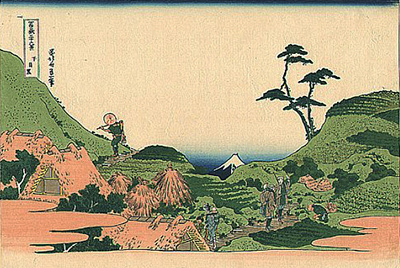Hokusai
Below Meguro by Hokusai
Below Meguro also referred to Lower Meguro or Shimo Meguro, in other publications is one of Katsushika Hokusai’s prints the famous series Thirty-six Views of Mount Fuji also known as Fugaku sanjūrokke. The printmaker and artist was born in 1760 in Japan, Tokyo, Edo District and died in 1868.
The print Below Meguro was produced in ca. 1830-1832 during the Edo period of between 1615 and 1868 in Japan. It was produced on a Polychrome woodblock print; ink and colour on paper and classified as a print with dimensions of 10 1/4 x 15 1/4 in. (26 x 38.7 cm), using an Ukiyo-e style. In the print Below Meguro, Hokusai countrified the area of hills and farming. It was believed that the area was where the shoguns hunted with the Falcon. On the lower right of Mount Fuji, Hokusai made an appearance of the hollow, where the two falconers were meant to stand on the pass-way and farmer kneel for them.
Most of these farmers during the Edo period had a lifestyle of living in houses with thatched roof as depicted on the print Below Meguro. The step-like pattern is for showing the vegetable fields that separated them from the Fuji Mountain. The landscape portrays a period and culture when the man takes a hoe to cultivate the fields while the woman takes up the responsibility of taking care of the kids back home. There are other amazing artworks from Utagawa Hiroshige’s printings about the Meguro that showcase the One Hundred Famous Views of Edo.
Hokusai earned part of his painting skills from his father Nakajima Ise who was a mirror-maker during the Edo period. However, analysists argue that he never inherited anything from his father because perhaps his mother was his father’s concubine. He nurtured his painting skills by joining the library and bookshop at the age four and later as an apprentice in wood craving at the age of fourteen where he started honing his printing skills.
